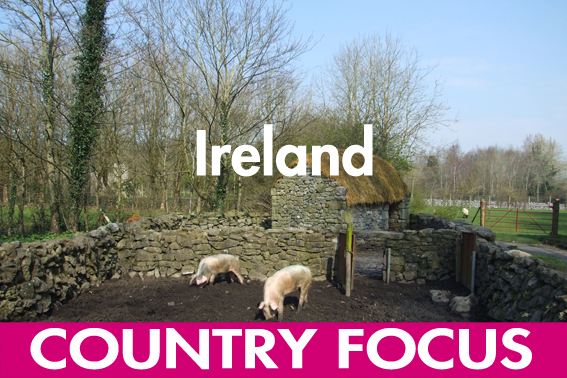Ireland’s pig sector – succeeding against all odds

Ireland has been thriving as a pig nation in recent years, with exports to Great Britain going well, among other things. So what has made the country stand out? Here’s a quick look at the pig industry, which is home to a number of this year’s key pig conferences.
Situated at the far western reaches of the European continent and surrounded by sea, Ireland is known for its green fields, damp climate – and Guinness. These characteristics would seem to imply that Ireland’s pig farmers are not at the top of the list when considering how competitive its industries are. Indeed, the Celtic blessing that wishes for soft rain on green fields suggests that Ireland’s comparative advantage would be found in dairy and grass-fed beef production – not in intensive, cereal-dependent livestock production. And, over the last decade, the country’s breeding herds of pigs have been shrinking. But closer examination of the performance achieved by the Irish pig and pig meat value chain suggests that the farmers and processors in this ‘Green Isle’ have succeeded against the odds, although they are feeling the same recent pressures felt by all of Europe’s pig producers.
According to Bord Bia (the Irish food promotion body), the supply chain for pigs and pig meat in Ireland involves about 400 farmers and another 7,500 workers engaged in feed, transport and processing activities. Together, they produce around 3.5 million pigs each year and more than a quarter of a million tonnes of pig meat and value-added products. Eighty percent of these pigs are slaughtered in Ireland and about 500,000 are exported live across the land border to Northern Ireland.

Irish pig meat exports doubled
Now, Ireland doesn’t have a big population (approximately 4.6 million people in the Republic of Ireland), so the basic statistics hint at an aspect of the Irish character that is worth highlighting – the ability to do a deal. From official data, we observe that Ireland is approximately 240% self-sufficient in pig meat so, sure enough, those deals are being done and the Irish are selling pigs and pig meat to markets on their doorstep and on the other side of the world.
Pig meat exports doubled between 2009 and 2015. The most recent Bord Bia report puts exports up by 13% in 2015. Export meat plant pig supplies in Ireland are estimated to have increased by some 6% in 2015 to reach 3.16 million head. This reflects a rise in the supply of pigs and was driven by a 3% increase in the breeding herd in 2014, coupled with increased productivity per sow. Supplies have also been boosted by a 4% decline in live exports in 2015 and an increase of almost 3% in carcass weights.
Altogether, this resulted in pig meat production of some 277,000 tonnes in 2015; a 9% increase. But in the latest Irish census (December 2015), the breeding herd contracted by almost 5%, compared with 2014, to 140,000 head.

Export destinations
The UK has long been a prime market and takes about a 3rd of all Ireland’s pork exports, plus some 40,000 tonnes of processed pig meat. About two-thirds of Irish pig meat is exported to other EU countries and one-third to non-EU markets. China, Denmark, Germany, Japan, the USA, South Korea, Australia and the Philippines are all export destinations for Irish pig meat products. China was Ireland’s second biggest overseas market for pig meat in 2015 and accounts for about half of Ireland’s non-EU market exports by volume. Bord Bia estimates that Ireland’s pig meat exports in 2015 had a total value of around €570 million (at consumer prices).
Main players in Ireland’s pork sector
The Rosderra Irish Meats Group is the largest pork processing company in Ireland and probably accounts for half the pig kill at its state-of-the-art slaughtering and processing facilities at Edenderry in County Offaly and Roscrea in County Tipperary. Rosderra exports about half of its output and its integrated business (including ownership of farms) and appetite for exports clearly give it a competitive edge. The other key players in the top 5 of Irish processors are Dawn Pork and Bacon, Stauntons, and Kepak.
Pork cuts exported
Bord Bia’s data provides a breakdown of national exports and two-thirds are muscle cuts. About 12% are in the form of processed pig meat, almost 10% are bacon and ham, 5% are sausages and 8% are offal. Bord Bia’s estimates for 2015 show net production of some 276,585 tonnes, with imports of 95,000 tonnes and exports of 233,000 tonnes.

Increasing productivity
Back on the farm, Ireland’s pig units have been doing their bit to boost productivity. According to the latest InterPIG report, Ireland’s average annual increase (2008-2014) in the pigs finished per sow per year is 1.34%. This compares with 0.88% for British farmers, 2.49% for Germany and 1.33% for Denmark. In another key metric – annual carcass meat production per sow – Irish farmers improved by an average annual rate of 2.26%, the Brits by 2.19%, the Germans 3.45% and the Danes 3.03%. These small differences hide the fact that, over time, the leaders in Europe’s pig production are outpacing the pack. Ireland’s farmers still have a chance in this race.
The future for the Irish pig industry
What does all of this say about the future of Ireland’s pig industry? Its weaknesses are its location and lack of cheap home-grown feedstuffs. Its strengths are trading ‘know-how’ and a growing presence on the world market for pig meat. On paper, the Irish pig industry doesn’t seem to be in the game for the long run. But don’t write off anyone who can sell pig meat to Denmark!
Ireland at a glance
With its 70,000 km2 and roughly 4.6 million inhabitants, the Republic of Ireland is one of the smaller countries in the European Union. The country’s pig industry involves about 400 farmers, producing roughly 3.5 million pigs annually. The country experienced very strong economic growth in the 1990s and the early years of this century, but this all came to a halt after the crisis of 2008. For the pig industry, the year 2008 meant a setback, as a dioxin contamination incident led to an international recall of pork products from Ireland. The affair led to massive protests by pig producers in the capital Dublin, calling for the
reopening of pig slaughter plants.











